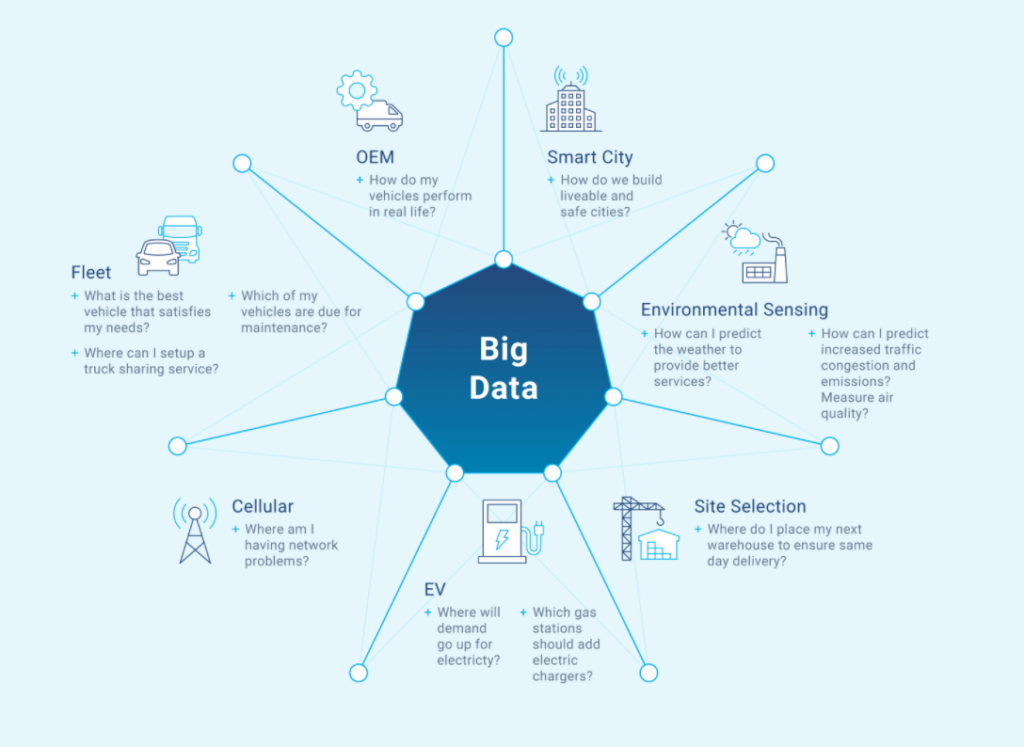October 7, 2021
Welcome to our Monday Minute Interview Series
In this series, Christopher Candy, VP, Business Development at Mobilizz™ sits down with the people and businesses of the Telematics industry. This week we caught up with:
Mike Branch

Mike is the vice president of data and analytics at Geotab and leads the charge for developing solutions that enable insight from over 2.1 million connected vehicles and 40 billion data points that Geotab processes on a daily basis. Mike joined the Geotab team in 2016, and prior to that was the CEO of Inovex Inc., which in 2013 spun off a brand new entity, Maps BI — a platform for geospatial data visualization. Maps BI was integrated within Geotab’s telematics platform as a key partner and was later acquired by Geotab in 2016. Mike has received numerous honors, including the University of Toronto Arbor Award and Early Career Award, Engineers Canada Young Engineer Award, Professional Engineers of Ontario Engineering Medal and the Cloud Innovation World Cup.
Chris and Mike cover a variety of topics including:
- the evolution of telematics
- the advantages and hurdles of big data analytics
- how to elevate your fleet data to get buy-in from the C-Suite
Read Time: 10 minutes
CC: You’ve been with Geotab since 2016, how has telematics and data evolved since then?
MB: The acumen of everybody in the realm of data science has heightened significantly. A few years ago, to get a data scientist was tricky. Scientists would claim to be a pro, and then just know how to use advanced excel functions. The university system had not quite caught up at that time. You contrast that to now where universities have done such a great job of preparing data scientists, you get some phenomenal candidates across the board. With regards to what we are doing now versus then, I think it’s incredible. We were just starting to push data into Google BigQuery at that time (2016). Now, we are starting to extract a lot more value. We’re not processing data from 400,000 vehicles anymore, it’s now 2.1 million vehicles, and because of that it is critically important that the systems you put in place scale well. If we did not put in the time and effort to make sure these systems scale really well, anything downstream would have been much more difficult to to execute. In terms of the democratization of data and AI, that has been really interesting. You’re starting to see simpler AI algorithms being activated, leveraging SQL-like syntax in BQML. We’ve grown used to writing code in SQL to query billions of records across a data warehouse, but today I can now write a machine learning model to cluster data or make predictions using that same syntax, which is really powerful. The way that you can analyze geospatial data at scale has changed drastically — what you can do with technologies like Google BigQuery and Snowflake is incredible. I think the industry has come a long way injust four years, and Geotab too. Geotab’s Data and Analytics team has grown from 5 to 60 people. With that, as you are trying to design these systems, it’s not just about the data anymore, it’s about privacy implications, data governance, and putting these systems in place. Because your AI learns from the data, making sure everyone knows what your pipeline looks like is important, too. And then, it’s bringing your whole organization up to speed. As an organization, we went from 200 employees to more than 1,300, so now you’re going to have more people pulling more data. The question is: how do you make sure people are pulling the right assets to do their work? We are not only supporting our Reseller base and our Customer base, but we also support internal customers too, making sure they have the tools in front of them to make intelligent decisions. So yea, a ton has changed in just four years.

CC: How should a telematics user look to get started with data, and how can they look to get buy in within their organization. It’s relatively early days, right?
MB: Oh it’s definitely early days, I would say. I think it depends on the size of the organization. Even for a small shop (1 to 10 vehicles), you can get a tremendous amount of value from data by using the core MyGeotab functionality and leveraging ready-made Add-Ins on the Geotab marketplace that can work seamlessly with the data derived from your fleet of vehicles. I highly recommend a “crawl-walk-run” approach, starting with what’s available before going down the route of doing your own modeling or combining telematics data with your line-of business data is a good start.As you start getting towards midsize and larger fleets, that’s when I think the power of the data can become that much more impactful. If you’re looking to extract more value, you could start off with a data science intern or begin working with data partners, I think there’s tremendous value there. If you’re starting with a single resource, make sure they not only have a data science background, but that it stems from software development,because that combination will help yield results in an application that you can actually put to use. Then the types of projects you might want to get started with could be fairly basic. It might be more descriptive analytics, because oftentimes anything involving Artificial Intelligence (AI) and Machine Learning (ML) will take a little bit longer. To help get some of that executive buy in, you will want to start looking to work on projects that may be quicker wins, which may be harder to do if you’ve never embarked on an AI project before. With AI projects, you must be astute enough to look at it and say: is this a project that is going to take a few weeks to do, or a few years? If you can’t make that distinction, you’re going to end up in perpetual R&D mode, which will make it very challenging to garner that executive buy in. For a customer looking to get some quicker wins, I would recommend leveraging some of the work that Geotab has already done, such as our electrical systems rating model. The cost of a vehicle going down because of a battery issue can be huge, while a battery is very simple to replace, it’s the downtime that is going to be the most impactful. For some of our larger customers, just having an idea of which vehicles are going to fail in advance, already you can equate that to potential downtime and cost savings. Focus on something that you can equate to savings, whether it be time savings or financial savings We have released the intelligent zoning feature in our new Analytics Lab Add-In in MyGeotab, so instead of having to manually create zones, you just have the system do it for you. There’s immediate time savings. It’s critical to make sure that you are very clear from the get-go – what is the intent with the project? What do the anticipated timelines look like? What savings, whether it be time savings, monetary, or safety, are you trying to achieve? Being crystal clear with your objective (as is the case in any project) is critical to achieve success with AI.

CC: You mentioned some of the great work you’ve done with customers already. Is there a data project in particular that stands out that had a huge positive impact for that customer?
MB: I definitely think the battery use case example mentioned above has yielded one of the biggest impacts for some of our larger customers from a monetary perspective – you can quantify how much it has actually saved them. The other one I would say is the fuel-economy benchmarking application. One of the things we try to do through our MVP team (Minimum Viable Products) is create exceptional products for customers. What we found was while they were working on projects for customers via this MVP approach, many of these projects weren’t finding their way out to the broader market. What we created to help solve this problem is our new Analytics Lab Add-In. As long as you install the Add-In, you’re able to see all the new things that we are pushing out to the ecosystem. One of them is the fuel economy benchmarking app. The idea behind the app is that we can now tell you: a) how your current vehicles are actually performing via real world MPG (Miles Per Gallon), and b) and how they are doing against other similar types of vehicles in similar usage patterns. You can then start to answer questions like: is it better for me to be driving a Chevy Silverado in the Rocky Mountains for this specific type of delivery, or does a Ford-150 make more sense? You can see what the numbers look like for your similar use cases. We want to encourage partners to build off these datasets.
CC: Without divulging confidential information, is there anything you’re working on at Geotab that you are really excited about that will be coming out in the near future, from a data perspective?
MB: Definitely look for more on intelligent transportation systems that impact government and smart cities. You can expect to see more AI-enabled decisions, too. One of the things that we are pushing hard on with new applications is answering the question: what action am I going to take as a result of seeing this data? Being able to act on an insight that we provide to you, and then quantifying what that actually means. For example, maybe you’re spending 1.5 times longer servicing a vehicle than another organization. Let’s quantify if you were actually able to achieve the best practice, what would that provide you in terms of savings? These kinds of AI-based recommendations are focused on what action you should take and how the results of those actions can be quantified in terms of savings. Again, I would keep your eyes peeled on Analytics Lab, because anything new we are doing is going to be a new experiment in the lab there.
CC: Through a lot of your interviews over the last year, we’ve heard you say “elevate your data”. Can you elaborate what you mean on that?
MB: Data should be used to help empower the whole business, and oftentimes we see it stuck in silos. Slowly but surely, I see some organizations beginning to digitally transform themselves Especially in the light of COVID-19, businesses have started to try to understand what data they have that can help make their organizations more efficient. Still, so often you still see this type of data only being used in a fleet management capacity and not being leveraged across any other areas of an organization. The perfect example is in municipalities. A municipality may be operating a fleet, but the fleet manager isn’t speaking to traffic or works. How can this whole system now be used to help better manage your municipality – it’s not just about the telematics device in the vehicle, but it’s about the data surrounding the whole ecosystem. In a municipality, the insight driven from this data is perfectly suited for applications like traffic corridor analysis and for assisting in Vision Zero safety programs. At the board level, we should figure out how we can leverage data to better the organization, as a cost savings metric, or looking for new opportunities. It should be reaching that level and so often it is making sure partners are prepared to do that.
CC: If you’re a fleet manager, how do you get buy-in across the other departments in the organization, and how do you get siloed departments to work together when certain departments are saying “keep your hands off my data”?
MB: To gain additional buy-in, you must showcase the results. An example of where we have seen that recently has been in the realm of Predictive Maintenance (PM). If you can show that you can start actively predicting some of these failures and what that equates to from a cost-savings perspective, that helps to start getting buy-in from everybody from procurement to finance. Picking something that will have an impact downstream on other departments is going to elevate the level of importance of the telematics data across the entire organization, and again PM is a pretty good one to look at. The data collaboration is a tricky one, because you have to have a mentality of openness and sharing your data. I think the reverse is a lot easier – convincing someone to share data when it’s theirs and it’s in their silo can be more challenging. Making sure you understand the motivation is important – why do you think that it’s your data and why does it need to stay within your department? If you can better the mission of the organization by leveraging some of this data, why wouldn’t you?
CC: Are there any challenges or hurdles for an organization that you encounter when a company looks to get involved with data analytics? Do you have any advice for companies when they are getting started that should be on the lookout for or make sure they avoid?
MB: Having the right talent is always very important, but also making sure that you’re very concrete about what problem you’re actually trying to solve is critical. Just saying “we’re going to spin up a project on utilization” is too vague. Utilization has so many meanings and connotations to different organizations, even within the same organization: are you looking at improving the viability of the right vehicles at the right time for a specific job?Are you looking at whether the vehicles are being used effectively? Are you looking at the dwell times of each of these vehicles? Is one serviceman taking longer on site than another? You can get easily dragged into the never ending world of data science,exploration and R&D, which is important, but if the fence post is too broad then you may never get to where you need to be.
As you deal with multinational and large organizations, the notion of data governance – data residency and data privacy – are usually top of mind. As regulations like CCPA in California and GDPR in Europe dictate what you can do from a privacy perspective, understanding the importance of data privacy within an organization is very important. Where does the data need to reside? How is it being governed? Being able to partner with an organization that understands those kinds of concepts and how to work within the realm of CCPA and GDPR and provide a solution that works, too, can be challenging. If you think about data being siloed into different countries, how to bring it together if you’re an MNC to drive meaningful insight can be challenging.
CC: Yea, wow that is huge, I never thought about that one.
MB: Yes, if you think about it, the data sometimes needs to reside in the country that is dictated by the customer, and if that data resides there, that’s great, but what about the data that resides in Canada, data that resides in the US, the EU? You’re one company, but you have to separate where the data resides, but at the same time you want centralized analytics. The two fight each other quite a bit, so having a strategy in place as to how you’re going to operationalize these things is key. In the US you’re getting disparate privacy legislation by state, so not only do you have to worry about data governance at the country level, you’re going to have to worry about these things at the state level, too. Data residency will likely still stick within the country of domain, but when it comes to privacy implications, there’s nuances per jurisdiction. Then the question becomes: now how do you innovate? It’s tough enough to innovate in normal circumstances, but now you have to innovate whilst respecting privacy and law across boundaries. Yet, if done thoughtfully, privacy and innovation can co-exist and not be at odds with one another.

CC: In your crystal ball, looking at the next 3 to 5 years, how do you see data evolving, particularly as it pertains to telematics? What role will 5G start to play in all of this?
MB: Quicker insights, for sure. Predictive models living on the edge (i.e. on the device itself) – you will see this more ubiquitously deployed. By that I mean, if you want to make a prediction about something, no longer will you have to wait for it to hit the cloud. You will do it right on the device at the edge. That will better enable things like vehicle-to-infrastructure communication. While we [Geotab] continue to focus on R&D and evolving our flagship product, the Geotab GO device, we are also seeing an appetite for OEM embedded telematics as well. But whether data comes from an embedded OEM device, or from the GO device, it won’t make much of a difference — it’s what you do with the data and the downstream insight that is most impactful. Furthermore, I think AI will continue to be democratized by the large players like Google, Amazon, and Microsoft, making it easier for organizations to leverage powerful AI predictive models using a single data analyst (which would have taken teams years to produce). That being said, democratizing AI is only a small part of the battle — working closely with customers to help instill action from the insight provided to achieve tangible ROI and results is where the rubber hits the road, so to speak. Many of our partners have already adopted this data-driven mindset, which has been growing in demand as our customer base matures. AI is just the next step on their data journey.

